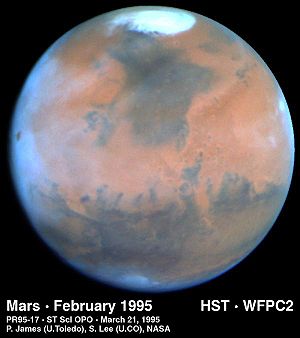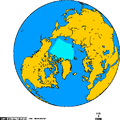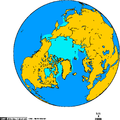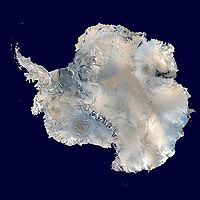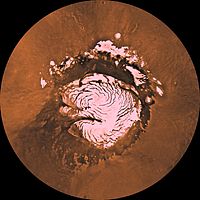
Polar ice cap
Did you know...
SOS Children made this Wikipedia selection alongside other schools resources. A quick link for child sponsorship is http://www.sponsor-a-child.org.uk/
A polar ice cap is a high-latitude region of a planet or moon that is covered in ice. There are no requirements with respect to size or composition for a body of ice to be termed a polar ice cap, nor any geological requirement for it to be over land; only that it must be a body of solid phase matter in the polar region. This causes the term 'polar ice cap' to be somewhat of a misnomer, as the term ice cap itself is applied with greater scrutiny as such bodies must be found over land, and possess a surface area of less than 50,000 km²: larger bodies are referred to as ice sheets.
The composition of the ice will vary. For example Earth's polar ice caps are mainly water ice, while Mars's polar ice caps are a mixture of solid phase carbon dioxide and water ice.
Polar ice caps form because high-latitude regions receive less energy in the form of solar radiation from the sun than equatorial regions, resulting in lower surface temperatures.
The polar ice caps have changed dramatically over the last 12,000 years. According to prevalent scientific theory, this change can be attributed to global warming resulting from climate change caused largely by the burning of fossil fuels. Seasonal variations of the ice caps takes place due to varied solar energy absorption as the planet or moon revolves around the sun. Additionally, in geologic time scales, the ice caps may grow or shrink due to climate variation. See ice age, polar climate.
Earth
North Pole
Earth's north pole is covered by floating pack ice (sea ice) over the Arctic Ocean, the Arctic ice pack. Portions of the ice that don't melt seasonally can get very thick, up to 3–4 meters thick over large areas, with ridges up to 20 meters thick. One-year ice is usually about a meter thick. The area covered by sea ice ranges between 9 and 12 million km². In addition, the Greenland ice sheet covers about 1.71 million km² and contains about 2.6 million km³ of ice.
While the International Panel on Climate Change 2001 report predicted that the North polar ice cap would last to 2100 in spite of global warming caused by climate change, the dramatic reduction in the size of the ice cap during the northern summer of 2007 has led some scientists to estimate that there will be no ice at the North Pole by 2030 with devastating effects on the environment.
Other scientists such as Wieslaw Maslowski, a professor at the Naval Postgraduate School, estimate that there will be no summer ice by as soon as 2013. He argues that this projection is already too conservative as his dataset did not include the minima of 2005 and 2007.
South Pole
The land mass of the Earth's south pole, in Antarctica, is covered by the Antarctic ice sheet. It covers an area of almost 14 million km² and contains 25-30 million km³ of ice. Around 70% of the fresh water on the Earth is held in this ice sheet. In addition, the West Antarctic Ice Sheet covers 3.2 million km² and the Ross Ice Shelf covers 0.5 million km². See Climate of Antarctica.
Global warming has increased the volume of summer meltwater on glaciers, which has weakened ice shelves. The dramatic collapses of The Prince Gustav Channel, Larsen Inlet, Larsen A, Wordie, Muller, and the Jones Ice Shelf show the impacts of climate change on the Antarctic ice cap.
Mars
The planet Mars also has polar ice caps, but they consist of frozen carbon dioxide as well as water. The ice caps change with the Martian seasons-the carbon dioxide ice sublimes in summer, uncovering a surface of layered rocks, and then reforms in winter.
